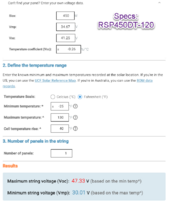wildcatden
New Member
The Setup will be two Renogy 320W panels in parallel. I can NOT mount the panels in any other location so the distance is required.
A. Do I need to put a fuse (maybe 40Amps) inline to be safe?
B. The panels are rated just above the 600W input max of the Yeti 3000X. The panels have a Vmp=33V and Imp=9.7A. It seems as if under absolutely optimum conditions, I might hit >600W. Perhaps using 10AWG or even 12AWG wire to ensure a voltage drop over the distance/resistance of the copper wire will ensure I don't go over.
C. For the 65 foot cable, I may not be able to get HPP on one end. In that case, I would have to get a short MC4 to HPP adapter cable in 12AWG. Does this cause an issue (heat? more voltage drop?) going from 12AWG at the panel to 8AWG copper and then back to 12AWG adapter for attaching to the Yeti3000X?
- Renogy 2-PC 320W Panels ( RNG-320Dx2-US ). 12AWG Output Cables with MC4 connectors. Voc=40.3V, Isc = 10.23 Amps.
- Renogy 2-to1 Y-branch Connector - MMF+FFM Pair. Rated 50 Amps
- 65 feet of 8AWG or 10AWG copper cables with MC4 (M&F) on one end and High Power Port (HPP/Anderson) connectors the other.
- Goal Zero Yeti 3000X High Power Charge Port (14-50V, up to 50Amps (600W Max)).
A. Do I need to put a fuse (maybe 40Amps) inline to be safe?
B. The panels are rated just above the 600W input max of the Yeti 3000X. The panels have a Vmp=33V and Imp=9.7A. It seems as if under absolutely optimum conditions, I might hit >600W. Perhaps using 10AWG or even 12AWG wire to ensure a voltage drop over the distance/resistance of the copper wire will ensure I don't go over.
C. For the 65 foot cable, I may not be able to get HPP on one end. In that case, I would have to get a short MC4 to HPP adapter cable in 12AWG. Does this cause an issue (heat? more voltage drop?) going from 12AWG at the panel to 8AWG copper and then back to 12AWG adapter for attaching to the Yeti3000X?



